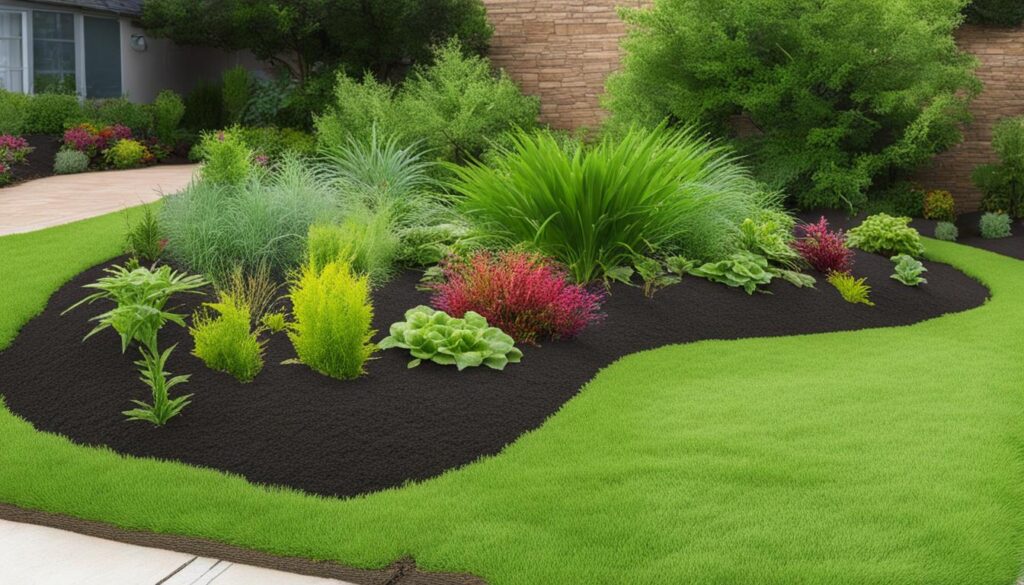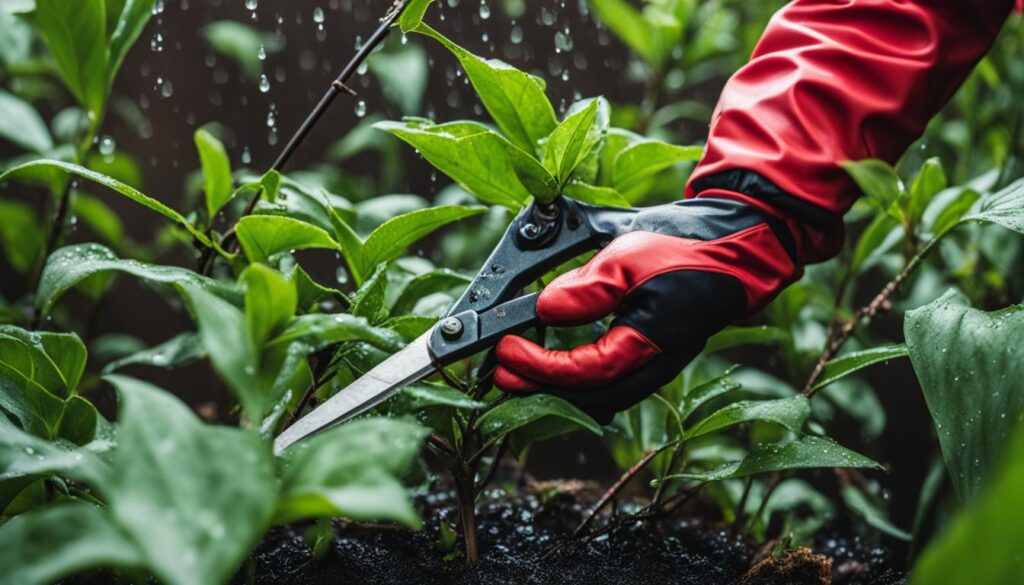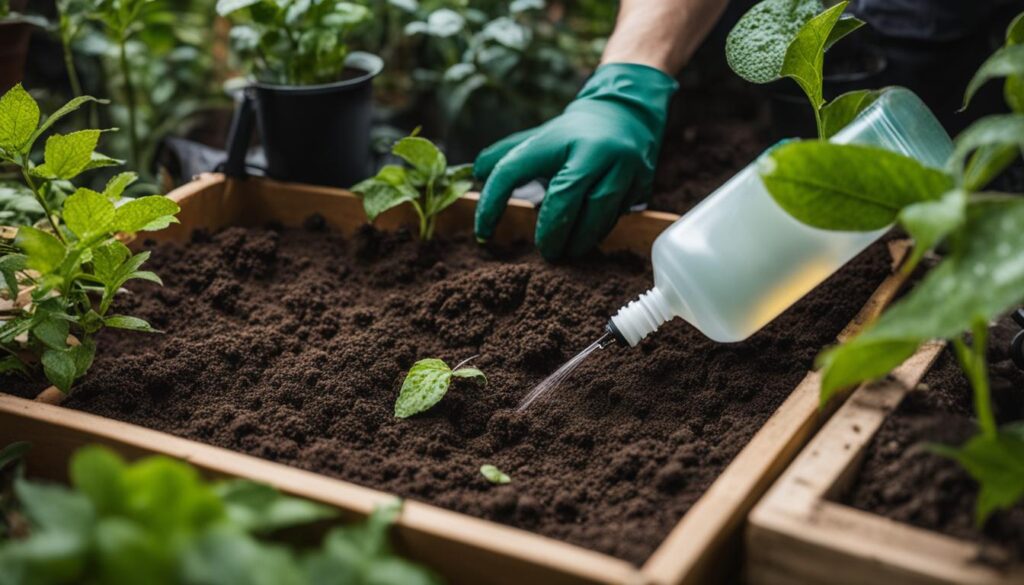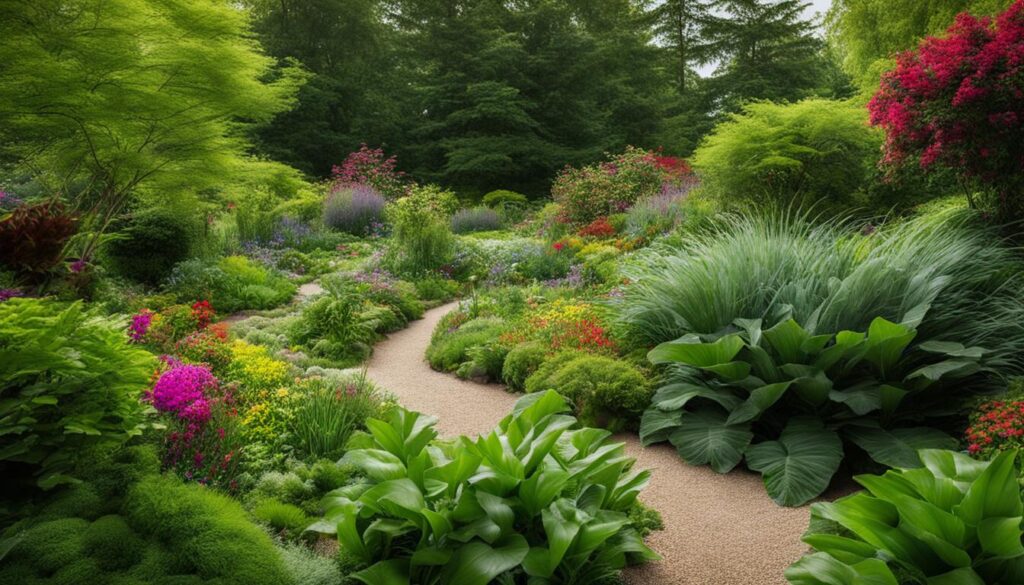Gardening is a rewarding and fulfilling hobby that brings beauty and tranquility to our outdoor spaces. However, when the rainy season arrives, it can present unique challenges for keeping our gardens thriving. But fear not! I’m here to share some valuable tips and insights on how to care for your plants during wet weather.
With a little extra attention and some strategic adjustments, you can protect your garden and ensure the health and vitality of your plants, even in the midst of heavy rainfall. Let’s dive into some expert advice that will help you navigate rainy day gardening with ease.
Key Takeaways:
- Adjust your watering frequency to account for the increased rainfall and avoid overwatering.
- Ensure adequate drainage in your garden to prevent waterlogged soil and plant root issues.
- Use organic mulch to retain moisture, prevent soil erosion, and suppress weed growth.
- Prune and stake your plants to maintain their structural integrity during rainstorms and strong winds.
- Regularly inspect and control pests and diseases that thrive in wet weather.
Adjust Watering Frequency
During rainy weather, it’s essential to monitor the moisture levels in your garden. Due to increased rainfall, you may need to adjust your watering routine accordingly. Take note of the frequency and intensity of rainfall, and only water your plants when necessary. Overwatering can lead to root rot and other fungal diseases. Aim to keep the garden soil moist, but not waterlogged.
It’s important to strike a balance between providing enough water for your plants’ needs and avoiding excessive moisture that can lead to problems. Relying solely on rainwater can be beneficial, but it is still important to pay attention to the moisture levels in the soil. As a general rule, if the top inch of soil feels dry, it’s time to water your plants.
Monitoring the moisture levels requires observation and adjustment of your regular watering routine. By staying vigilant and attentive to the needs of your plants, you can help prevent overwatering and keep them healthy and thriving.
Tip: Use a moisture meter to accurately assess the moisture content of your garden soil. This tool can provide a more precise measurement and help guide your watering decisions.
| Signs of overwatering: | How to prevent overwatering: |
|---|---|
| Yellowing leaves | Avoid frequent and excessive watering |
| Drooping or wilting plants | Water plants only when necessary |
| Fungus or mold growth | Provide proper soil drainage |
| Root rot | Ensure plants have adequate airflow |
Preventing overwatering and root rot
Overwatering can lead to root rot, a condition where the roots of the plant become waterlogged and start to decay. Root rot can be detrimental to the overall health of your plants and may even cause them to die. By adjusting your watering frequency and following these tips, you can help prevent overwatering and protect your plants from root rot:
- Know the water requirements of different plant species in your garden.
- Check the moisture level of the soil regularly with a moisture meter or by performing the finger test.
- Water your plants deeply but less frequently to encourage deep root growth.
- Ensure proper soil drainage by amending clay or compacted soils with organic matter.
- Avoid watering during periods of heavy rainfall to prevent waterlogging.
- If you notice signs of overwatering, adjust your watering routine accordingly.
Remember, maintaining the right moisture balance is key to the health of your plants. By adjusting your watering frequency and keeping a close eye on the moisture levels in your garden, you can promote healthy plant growth and prevent issues such as root rot and fungal diseases.
Ensure Adequate Drainage
To prevent waterlogged soil, it is crucial to ensure proper drainage in your garden. Wet soil can suffocate plant roots and promote the growth of fungi and diseases.
One effective method to improve drainage is by incorporating organic matter such as compost or well-rotted manure into your soil. This addition helps to improve the soil’s structure and its ability to drain excess water.
“Incorporating organic matter into the soil can improve its drainage capabilities and create a healthier environment for plant roots.” – Gardening Expert
Additionally, consider creating gentle slopes or installing drainage systems to redirect excess water away from your plants. This way, you can ensure that water flows away from the plant roots and prevents waterlogging.
| Methods to Ensure Adequate Drainage | Description |
|---|---|
| 1. Incorporate Organic Matter | Add compost or well-rotted manure to improve soil structure and drainage capabilities. |
| 2. Create Slopes | Build gentle slopes to redirect excess water away from plants. |
| 3. Install Drainage Systems | Consider installing drainage systems to effectively remove excess water from the garden. |
By ensuring adequate drainage in your garden, you can create a healthier environment for your plants, reducing the risk of root suffocation and fungal diseases.

Use Mulch
Mulching is a highly beneficial practice during the rainy season. It provides numerous advantages that contribute to the health and vitality of your garden. By applying organic mulch such as wood chips or straw, you can create a protective barrier around your plants, offering a range of benefits:
- Retains Moisture: Mulch helps the soil retain moisture, ensuring your plants have a constant water supply even during heavy rains. This is especially important for plants with shallow root systems.
- Prevents Soil Erosion: The layer of mulch acts as a shield, protecting the soil from erosion caused by heavy rain and strong winds. It keeps the soil in place, preventing nutrient loss and maintaining its structure.
- Suppresses Weed Growth: Mulch acts as a natural weed barrier, preventing weed seeds from germinating and competing with your plants for water and nutrients. This reduces the amount of time and effort spent on weed control, allowing your garden to thrive.
Furthermore, organic mulch, such as wood chips or straw, not only provides these benefits but also adds organic matter to the soil as it breaks down over time. This improves soil fertility and enhances overall plant health.
Using organic mulch in your garden during the rainy season is like giving your plants a protective blanket that helps retain moisture, prevent soil erosion, and keep pesky weeds at bay. It’s a win-win situation for both you and your plants!
Remember to apply a layer of mulch around your plants, making sure to keep it a few inches away from the stems to prevent rotting. Spread it evenly to a depth of two to four inches, allowing it to cover the soil surface effectively.
Types of Organic Mulch
There are various types of organic mulch available, each with its own unique qualities. Here are a few common options:
| Organic Mulch | Description |
|---|---|
| Wood chips | Durable and long-lasting; helps regulate soil temperature and moisture levels. |
| Straw | Lightweight and easy to spread; breaks down relatively quickly, improving soil structure. |
| Leaves | Abundant and cost-effective; provides excellent insulation and nutrient enrichment. |
| Grass clippings | Fresh clippings can form a dense mat that prevents weed growth and adds nitrogen to the soil. |
Choose the organic mulch that suits your garden’s needs and availability. Regardless of the type you choose, the key is to create a protective layer that retains moisture, prevents soil erosion, and keeps weeds under control.
So, go ahead and embrace the power of mulch to enhance the beauty and health of your garden during the rainy season!
Prune and Stake Plants
Rainstorms can bring strong winds that pose a risk to your plants. The weight of rainwater combined with gusty winds can make plants top-heavy and vulnerable to damage. To maintain the structural integrity of your plants and protect them from the elements, it’s important to employ pruning and staking techniques.
First, pruning is essential for removing dead or weak branches that may break and cause harm during a storm. By pruning regularly, you can ensure that your plants are strong and healthy, better able to withstand the challenges of rainy weather. So grab your pruners and carefully inspect your plants, removing any branches that show signs of decay or weakness.
Additionally, staking tall plants or those with delicate stems can provide extra support, preventing them from bending or breaking under the weight of rainwater. Use stakes made of bamboo, wood, or metal to prop up your plants, taking care not to damage the roots.
So whether it’s pruning to remove dead branches or staking to provide support, these simple techniques can go a long way in safeguarding your plants and promoting their overall health and longevity.
To illustrate the benefits of pruning and staking, here’s an image of a well-maintained garden with staked plants:

Control Pests and Diseases
Wet weather provides an ideal environment for pests and plant diseases to thrive. To protect your garden, it is crucial to regularly inspect your plants for signs of infestation or disease. Look for yellowing leaves, spots, or unusual growth, as these often indicate a problem. Promptly remove any affected plant parts to prevent the spread of infections.
If you notice signs of pests or diseases, don’t panic! There are organic solutions that can help you regain control. Consider using organic fungicides or insecticides, which effectively target pests and diseases while preserving the health of beneficial insects.
Insecticides can be applied directly to plants or used as a preventative measure to ward off potential infestations. Organic fungicides combat fungal infections and can be sprayed onto affected areas.
Regular inspection and early intervention are key to managing pests and diseases in wet weather. By taking active measures, you can maintain a thriving and beautiful garden.

Organic Pest and Disease Control
When it comes to controlling pests and diseases, organic options are not only effective but also environmentally friendly. Here are some popular organic treatments:
| Treatment | Description |
|---|---|
| Neem Oil | A natural insecticide and fungicide derived from the neem tree. It disrupts the life cycle of pests and inhibits fungal growth. |
| Diatomaceous Earth | A powdery substance made from fossilized diatoms. It scratches the exoskeleton of insects, causing dehydration and death. |
| Garlic Spray | A homemade solution made by blending garlic cloves with water. It repels pests and has antifungal properties. |
| Copper Fungicide | A natural compound that controls fungal diseases. It works by preventing spore germination and disrupting fungal enzyme activity. |
| Bacillus Thuringiensis (BT) | A naturally occurring bacteria that targets specific insect larvae, including caterpillars, without harm to beneficial insects. |
Remember, prevention is the best defense against pests and diseases. Maintain good garden hygiene, including removing dead plant material, practicing crop rotation, and providing adequate air circulation. These measures, combined with regular inspections and organic treatments, will help you keep your garden healthy and thriving.
Ensure Adequate Air Circulation
Proper air circulation is crucial for plant health, particularly during rainy periods when humidity levels are high. Adequate air circulation helps reduce the risk of fungal diseases and keeps your plants thriving. To ensure proper air circulation in your garden, consider the following tips:
- Trim back foliage: Regularly trim back any dense foliage that obstructs the flow of air. This includes overgrown branches, leaves, or shrubs that create a barrier preventing air movement.
- Thin out overcrowded plants: Overcrowded plants can impede airflow and create a conducive environment for fungal diseases. Space out your plants appropriately to allow air to circulate freely around each plant.

By implementing these simple practices, you can promote better airflow and reduce the risk of fungal diseases in your garden.
Protect Sensitive Plants
Certain plants are more vulnerable to excessive moisture during the rainy season. To ensure their well-being, it’s important to provide additional protection.
One effective way to protect delicate plants from heavy rain and prevent waterlogging is by covering them with row covers or cloths. These protective barriers shield the plants from excessive moisture while allowing air circulation, ensuring their overall health.
If you have potted plants, another option is tomove them to covered areas, such as patios or balconies, until the rain subsides. This simple step can provide a safe and dry environment for your plants, allowing them to thrive even during the rainy season.
By taking these precautions, you can safeguard your sensitive plants from the damaging effects of excessive moisture and enjoy a flourishing garden throughout the rainy season.
Regularly Inspect and Clean Gutters
Blocked or overflowing gutters can cause a range of problems, including water pooling around the foundation of your home or garden. This can lead to waterlogging, which can cause significant damage in the long run. To prevent such issues, it is crucial to regularly inspect and clean your gutters. This simple maintenance task ensures proper water flow and helps in preventing water from accumulating near your plants. By taking care of your gutters, you can safeguard your garden during the rainy season and maintain a healthy environment for your plants to thrive.
Why Regular Inspection and Cleaning is Important?
Inspecting and cleaning your gutters on a regular basis is essential to keep them in good working condition. When gutters get blocked, they are unable to channel rainwater away from your home or garden effectively. This can result in water pooling around the foundation, causing potential damage to the structure and leading to waterlogged garden beds. By identifying and clearing any blockages in your gutters, you can ensure proper water flow and prevent these issues from occurring.
Consequences of Blocked Gutters
“Blocked gutters can create a chain reaction of problems that affect both your home and garden. If left unaddressed, these issues can culminate in foundation damage and other costly repairs.”
Here are some of the consequences that can arise from blocked gutters:
- Water pooling around the foundation of your home, potentially causing cracks and structural damage.
- Overflowing water seeping into basements or crawl spaces, leading to dampness and mold growth.
- Excessive moisture in the garden, resulting in waterlogged soil, root rot, and the promotion of fungal diseases.
- Erosion of garden beds and landscape features due to uncontrolled runoff.
Preventing Foundation Damage and Water Pooling
Regularly inspecting and cleaning your gutters is a proactive step towards preventing foundation damage and water pooling. Here’s what you can do:
- Use a sturdy ladder and carefully access your gutters to inspect them for any debris, leaves, or blockages.
- Remove any obstructions by hand or use a garden trowel to ensure unimpeded water flow.
- Check the downspouts for clogs and clear them if necessary.
- Consider installing gutter guards or screens to prevent leaves and debris from accumulating in the first place.
Regular maintenance, such as inspecting and cleaning gutters, is a small but crucial task that can save you from potential headaches and costly repairs in the future. By maintaining proper water flow, you can protect the foundation of your home and maintain a healthy garden environment.
| Benefits of Regular Gutter Inspection and Cleaning | Consequences of Neglecting Gutter Maintenance |
|---|---|
| Prevents water pooling near the foundation | Foundation damage |
| Ensures proper water flow | Waterlogged garden beds |
| Prevents erosion and landscape damage | Mold growth in basements or crawl spaces |
| Promotes a healthier garden environment | Cracks and structural damage to the home |
Regularly inspecting and cleaning your gutters is a simple yet effective way to protect your home and garden from the damaging effects of blocked gutters. By ensuring proper water flow, you can prevent water pooling around the foundation, waterlogged garden beds, and other potential issues. Take the time to maintain your gutters, and you’ll enjoy a healthy and thriving garden, even during the rainy season.
Improve Soil Drainage and Prevent Compaction
Wet weather can have a detrimental effect on soil, causing it to become waterlogged and compacted. To ensure optimal plant growth and prevent these issues, it’s important to take proactive measures to improve soil drainage and prevent compaction. Here are some effective strategies:
Avoid walking on soil
Walking on wet soil can lead to compaction, which reduces air pockets and restricts water drainage. To minimize compaction, avoid walking on soil whenever possible, especially during or after heavy rainfall.
Use a hand fork to loosen soil
Loosening the soil helps to improve its structure and create better drainage. Using a hand fork, gently loosen the soil in borders and pots to break up compacted areas and create channels for water to flow.
Aerate your lawn
If you have a lawn, aerating it can greatly improve soil drainage. This process involves creating small holes in the soil to loosen it, allowing air, water, and nutrients to penetrate deeper into the root zone. You can use a lawn aerator, a large digging fork, or a scarifying rake to achieve this.
Improve soil structure
Enhancing the structure of your soil is essential for maximizing drainage. Adding organic matter such as compost or well-rotted manure can improve soil structure by increasing its ability to retain moisture while allowing excess water to drain away. Incorporate organic matter into the soil regularly to maintain its health and structure.
Implementing these strategies will not only prevent soil compaction and waterlogging but also promote optimal plant growth and overall garden health.
Conclusion
In conclusion, gardening during the rainy season requires special care and attention, but with the right strategies, you can keep your garden flourishing even in wet weather. By adjusting watering frequency, ensuring adequate drainage, using mulch, pruning and staking plants, controlling pests and diseases, ensuring proper air circulation, protecting sensitive plants, regularly inspecting and cleaning gutters, and improving soil drainage, you can create a thriving garden despite the rain. With these tips, you can enjoy a garden filled with lush foliage and vibrant blooms, even on the rainiest of days. Happy gardening!
FAQ
How often should I water my plants during rainy weather?
Only water your plants when necessary, taking into account the frequency and intensity of rainfall. Aim to keep the garden soil moist, but not waterlogged, to prevent root rot and fungal diseases.
How can I ensure adequate drainage in my garden?
Incorporate organic matter, such as compost or well-rotted manure, into your soil to improve its structure and drainage capabilities. You can also create gentle slopes or install drainage systems to redirect excess water away from your plants.
Why is mulching important during the rainy season?
Mulching helps retain moisture in the soil, prevents soil erosion, suppresses weed growth, and acts as insulation, reducing the impact of heavy raindrops on delicate foliage. Apply a layer of organic mulch, such as wood chips or straw, around your plants to create a protective barrier.
How should I prune and stake my plants during rainstorms?
Prune your plants and remove any dead or weak branches to maintain their structural integrity. Consider staking tall plants or those with delicate stems to provide extra support and prevent them from bending or breaking under the weight of rainwater.
How can I control pests and diseases during wet weather?
Regularly inspect your plants for signs of infestation or disease and remove affected plant parts promptly. Applying organic fungicides or insecticides, if necessary, can help control the problem without harming beneficial insects.
Why is adequate air circulation important for plant health during rainy periods?
Proper air circulation reduces the risk of fungal diseases by allowing foliage to dry more quickly after rain showers. Trim back any dense foliage or overcrowded plants to ensure better airflow.
How can I protect sensitive plants from excessive moisture?
Consider covering delicate plants with row covers or cloths to shield them from heavy rain and prevent waterlogging. Alternatively, you can move potted plants to covered areas, such as patios or balconies, until the downpour subsides.
Why is it important to regularly inspect and clean gutters?
Blocked or overflowing gutters can lead to water pooling around the foundation of your home or garden, causing waterlogging and potential damage. Regularly inspect and clean your gutters to ensure proper water flow and prevent water from accumulating near your plants.
How can I improve soil drainage and prevent compaction during the rainy season?
Avoid walking on your soil wherever possible and use a hand fork to loosen the soil in borders and pots. If you have a lawn, consider aerating it using a lawn aerator, large digging fork, or scarifying rake to improve soil drainage and prevent compaction.


[…] Whether you’re a fan of fruity concoctions, protein-filled options, or unique flavor combinations, we have a wide variety of recipes to cater to your taste buds. From homemade favorites to nutrient-packed creations, our smoothies will keep you energized and satisfied throughout the day. […]